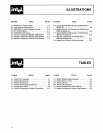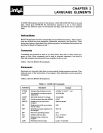
CHAPTER 2
LANGUAGE ELEMENTS
A BASIC-80 program consists
of
instructions, which tell BASIC-80 what to do, and
data, which gives BASIC-80 the inform.ation necessary to do it. This chapter
describes the different types
of
instructions and data, and shows how to represent
them.
Instructions
BASIC-80 performs work by interpreting user-provided instructions. These instruc-
tions are divided into three categories: commands, statements, and functions. These
instruction types are described in the following topics; the individual instructions are
described in detail in Chapters 6 and 7.
Commands
Commands are executed as soon as you enter them; they alter
or
direct entire pro-
grams or files. Most commands can be used in program statements, but many
of
them halt program execution and force variables to zero or null.
Table
2-1
lists the BASIC-80 commands.
Statements
Statements are executed when they are encountered during program execution. They
make up most
of
the instructions
of
a program. Most statements can be entered as
commands.
Table 2-2 lists the BASIC-80 statements.
Table
2-1. BASIC-SO
Commands
Command
Description
Example
ATTRIB
Changes the attributes of a file.
ATTRIB
"~F1
:STAT",
"W1"
AUTO
Automatically
numbers program
AUTO
25,500
statements.
CLEAR
Sets aside memory
for
strings.
CLEAR
2000
CONT
Continues execution
after
BREAK.
CONT
DELETE
Deletes a
line
or
lines
from a
DELETE
700~875
program.
DIR
Displays a
list
of
all non-invisible
DIR1
files
on
a disk.
EDIT
Specifies a program statement
to
EDIT
170
be changed.
EXIT
Retu rns
to
operating system .
EXIT
KILL
Deletes a file from disk.
KILL ":F1 :STAT"
LIST
Displays a
line
or
lines
of
a
LIST
300-400
program.
LOAD
Retrieves a file from disk.
LOAD ":F1 :DATES"


















